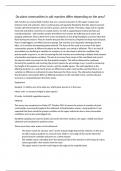Do plant communities in salt marshes differ depending on the area?
Salt marshes are coastal tidal marshes that are a coastal ecosystem in the upper coastal zone
between land and saltwater, that is continuously and regularly flooded by the tide. Species present
include salt-tolerant plants such as herbs, grasses, and low shrubs. They play a large role in aquatic
food web and deliver nutrients to coastal waters. As well as supporting terrestrial animals and
coastal protection. Salt marshes protect shorelines from erosion by buffering wave action and
trapping sediments. Rivers often form in the marshlands on low lying floodplains and near lakes that
flood during wet season. They are marshy because the soil may be composed of deep mud and peat.
Peat is waterlogged, root-filled and very spongy. Salt marshes are frequently submerged by the
tides, so it contains decomposing plant material. The focus of this study is to survey if the plant
communities present at different locations on the marsh, are varied or different. This is to check if
any habitats are declining in variation or numbers. It can also show is what the conditions the
species prefer to grow in, as well as ensuring the salt marshes are continuing to display their purpose
of protection and species variation. The aim is to survey three zones of the marshland and record
the species which are present in the five quadrat samples. This will be delivered by randomly
throwing five quadrats and counting the present species by percentage cover, as well as measuring
the height of the species in all four corners, and the middle square. The null hypothesis is the
differing locations on a salt marsh shows no difference in plant communities and that there is no
variation or difference in physical structure between the three zones. The alternative hypothesis is
that the plant communities differ at differing locations on the intertidal marsh, and the physical
structure is variated between the three zones.
Equipment:
Quadrat- To define area to be able see, which plant species is in the zone.
Metre ruler- to measure height of plant species
ID cards- to identify vegetation species
Method:
The survey was conducted on Friday 18th October 2019 to assess the extent of zonation of plant
communities occurring throughout the saltmarsh at Southampton waters, using quadrats. It was
expected that there would be greater variation on the upper saltmarsh due to more favourable
conditions such as less waterlogged soil.
Stratified sampling was used to divide salt marsh into three sections, the upper, middle and lower
saltmarsh and conducted a quadrat survey.
There were three clear zones on this saltmarsh:
· The lower marsh (or ‘pioneer zone’) at the seaward edge beyond the cheniers. In this area
we did not place quadrats on areas of loose shells or very edge of the marsh where the
ground may be unstable and poses as a safety hazard.
· The middle marsh, extending from the landward side of the cheniers to the fringe of rushes
(Juncus gerardii) a few metres from the road
· The upper marsh, from the rush fringe to the edge of the roadside bank
, The quadrat was thrown randomly 5 times in each section to record plant species found inside the
quadrat, the percentage cover and plant height. The maximum vegetation height was measured in
each corner square of the quadrat, and in a central square.
Results:
Lower zone
Quadrat (lower) Plant species Percentage cover Height (cm)
1 Halimione portulacoides 36% 21, 7, 14, 17, 17
Salicornia europaea 64%
2 Spartina anglica 83% 37, 37, 52, 16, 36
Salicornia europaea 17%
3 Salicornia europaea 100% 14, 16, 18, 15, 6
4 Glaux maritima 100% 22, 25, 31, 18, 21
5 Glaux martima 15% 26, 28, 15, 31, 42
Aster tripolium 15%
Limonium humile 15%
Salicornia europaea 5%
Puccinellia maritima 50%
Species name Mean % of Standard Standard error
coverage deviation
Halimione 5 16.286 7.283
portulacoides
Salicornia europaea 37 43.275 19.353
Spartina anglica 17 37.121 16.623
Glaux maritima 23 43.532 19.468
Puccinellia maritima 10 22.361 10.0001
Aster tripolium 3 6.708 2.999
Limonium humile 3 6.708 2.999
Graphs:
Lower marsh
40
35
30
25
mean percentage coverage
20
15
10
5
0
es ae
a ica m
a
m
a
iu
m ile
id gl iti iti ol m
c o rop an ar ar i p hu
la eu r
rtu na m m rt iu
m
o rn
ia rti ux l ia te on
p a
Gl
a el As
ne l i co Sp ci n Lim
io Sa c
lim Pu
Ha
Quadrats




